Square Peg, Round Hole: Grand Wagoneer restomod as unwilling tow rig
There comes a moment in any automotive project where expectations butt up against reality. Sometimes this occurs early on, when the sheer, terrifying scope of what has to be done stretches out in front of you like an endless sea, floating bonfires of cash glinting like beacons of despair in the distance. More often, I find, that reckoning hits hardest just after reaching a major checkpoint in the build process; it might be the initial turn of the key after an engine has been put back together, that first pass down the quarter-mile, or maybe even the reaction of your family when you finally escape the shop and park your reconstructed ride in the driveway at home.
For the past few years, I’ve been chronicling the transformation of my 1987 Jeep Grand Wagoneer here at Hagerty Media. In that time, I have guided from hidden survivor to restomod daily driver. Each step I’ve taken in that build process—from swapping in an LS engine, to replacing the gearing in the front and rear differentials, to overbuilding the cooling system, installing a hydroboost braking system, and even refurbishing the tape deck—has been with one overarching goal in mind: a cool classic SUV that would both ooze old-school charm and start every single time I needed it to.
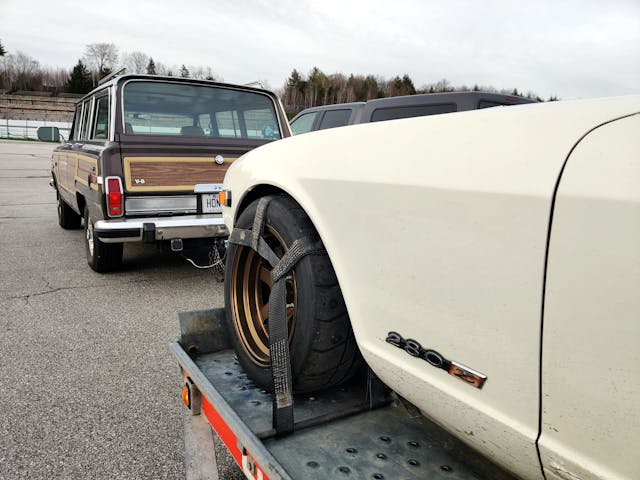
There was also, I must admit, a practical application: towing my 1978 Datsun 280Z. I was no longer comfortable driving hundreds of miles to and from the track in my Datsun, especially while enduring the merciless summer heat. Hence the need for a tow rig, which meant adding a list of upgrades to the Grand Wagoneer that went above and beyond what might have been “strictly necessary” for a simple LS swap. All so I could hitch up and drive off into the sunset hauling ancient J-tin on a trailer behind me.
When it came time to do exactly that, I found myself face-to-face with a startling, unexpected situation—one that unveiled something about myself more than it did about the vehicle I was driving.
An Inauspicious Start
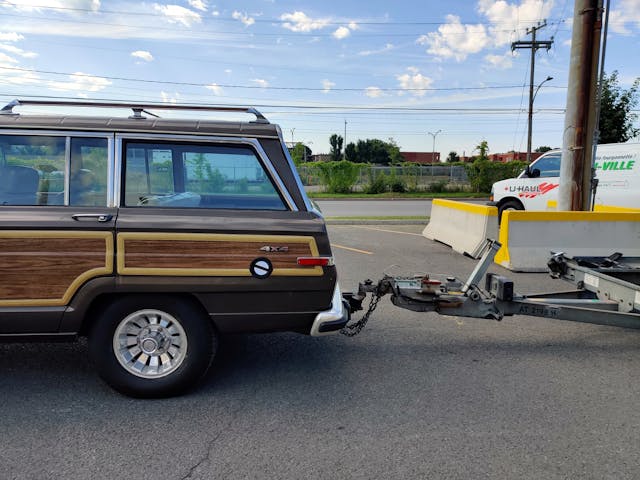
In the fall of 2022 I attempted towing with my Jeep Grand Wagoneer. I quickly discovered that the Jeep’s ancient, sagging OEM springs had trouble safely handling an unladen U-Haul trailer, let alone one transporting 2500 pounds of Datsun. By the time I had installed a full set of replacement leafs (and load-leveling airbags at the rear), track season was finished for the year, postponing a true test of the new setup until spring’s thaw.
Once April 2023 rolled around, I was raring to go. I’d spent the winter months fantasizing about how much I’d enjoy rolling down I-91, aiming at my first time trial event of the season at New Hampshire Motor Speedway. I could practically hear the Jeep’s 5.3-liter V-8 bellowing out a joyous bass note through the White Mountains, my Z securely locked into place on an affordable rental trailer of dubious quality.
Before I could even hit the highway on-ramp, the whole trip was nearly cut short. At U-Haul, the clerk wouldn’t let me leave the lot with the trailer due to a malfunctioning right-side blinker on the trailer harness. It took about three hours of detective work with the help of nearby AGM Performance (the shop that had installed the LS under the hood of my Jeep), a burned-out signal box, and several return visits to U-Haul for parts. In the end, a new harness installed under the back bumper satisfied U-Haul’s scrupulous safety mavens.
Trailer in place, I was now significantly late to met my father just on the other side of the Quebec/Vermont border, so I hurried home to load up the car. Because I live in the heart of Montreal and don’t have a long driveway, this task had to be completed street-side. Fortunately there is a school zone right out front, which is almost always free of parked cars for the seven or so Jeep-lengths I needed to line up the Z in front of the ramps.
We began to load up. Then came the second insult of the morning: the sound of screeching metal. A curled lip at the very end of the trailer gouged a valley along the Datsun’s decades-old undercoating and left a tidy pile of sadness just behind the back wheel.
A Shaky Foundation
Leaving aside the Z’s unrelated underbody gouge, there are several reasons why an ’80s Jeep Grand Wagoneer makes for a poor towing platform. Although I had taken care of most of them—the lack of power from the original AMC boat anchor engine, the somewhat sketchy nature of its factory brakes, and the tendency for its hindquarters to “wag-sag” under load—there was little I could do about its most limiting characteristic: short wheelbase.
The wheelbase of the original Grand Wagoneer checks in at 110 inches, or three feet less than what you’d find on a current-model-year pickup truck. As a result, it’s particularly sensitive to tongue weight and to the side-to-side sway of a trailer when traveling at highway speeds. Normally I would be able to make use of a load-distributing hitch to help push some of that tongue mass onto the front axles, but U-Haul trailers do not allow for that option due to the design of their surge brake system, which requires that the neck move freely. The trailers also have the propensity to pile on tongue weight via a loading strap system that requires parking the carried vehicle as close to the front of the deck as possible. Finally, there’s the pesky fact that the trailer, Datsun, and assorted gear on board combined to weigh awfully close to the Grand Wagoneer’s 5000-pound tow rating.

As soon as my fiancée and I cleared the city, it became clear to us that the Jeep was highly sensitive to any trailer movements, which might be caused by rough pavement, changes in speed, or even the lateral gravitational pull of ordinary bends in the road. Each steering input and every tap of the brake pedal invited bad behavior from the train I was conducting; I carefully policed my movements so as not to instigate any more wiggle than I could comfortably control with the Grand Wagoneer’s already nautically vague steering setup.
Once across the border, I stopped to fuel up and add air to the rear bags, increasing pressure from 60 psi to 80 psi (but still leaving 20 pounds of leeway below their theoretical maximum rating). This seemed to help somewhat with the rig’s lapsed adherence to tracking straight, and it allowed me to slightly relax the hyper-vigilant state I had assumed. Still, I watched my side mirrors and tuned in to the twist transmitted to my tuchus for any indication of impending trailer chaos.
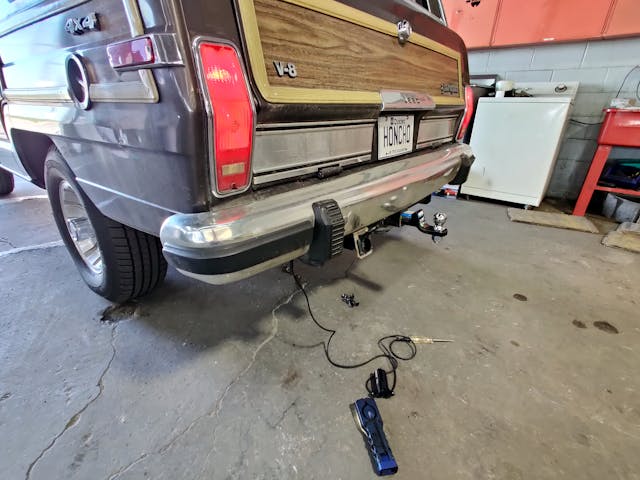
With that issue settled to my relative satisfaction, a new, more viscous one emerged.
The 4L60E transmission yoked to my Jeep’s LS-series V-8 contains three forward speeds plus overdrive. To safely tow any appreciable load (especially over mountainous roads) it’s necessary to lock-out OD and stick with third gear, thus avoiding heat build-up and possible damage to the transmission.
The consequence of this situation was a near-constant engine drone from 2700 to 3000 rpm, depending on steepness of the road. While I could suffer the extra-loud engine noise, the seals on my motor weren’t quite as willing to. After one particularly cacophonous downshift to second gear to maintain 70 mph up a long and steep grade, the revs briefly rose past 4000 rpm. After that, I began to notice a strange speckling on the rear window. Figuring it was just accumulated dust from the road surface, I ignored it … until it began to blot out my view through the back glass.

It wasn’t until I had pulled into the entrance at the track in New Hampshire I ran a finger over the window. The dot matrix printed across the back glass was, in fact, engine oil.
Not only was the back of the Jeep covered in the stuff, but my gleaming white Datsun had also become a sullied grey-cream, coated by a slick of lubricant that would no doubt impress the officials at tech inspection the following morning.

According to the dipstick, the Jeep’s engine was down a full quart of oil, which for just a two-hour drive is quite considerable. Most of the missing 10w30 was noticeable all along the underside of the Grand Wagoneer. I was, however, unable to pinpoint the exact source; the top of the engine was completely dry, and there were no hoses, seals, or breather valves in obvious distress.
Project-Truck-As-Therapist
I’d like to be able to tell you that the trip back home was better. That once I knew what to expect from the Jeep’s sketchy towing dynamics and frightening thirst for oil, I could better deal with the stress of the entire experience. Unfortunately, that wasn’t the case. Instead, I compounded the tension of the previous day’s difficulties by berating myself for landing in this position in the first place.
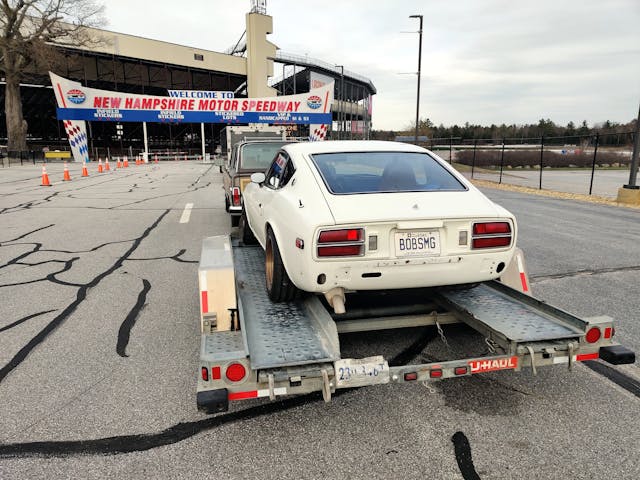
I felt stupid. Stupid for having invested so much time, effort, and cash into a project that could not complete a task for which I intended it. Yes, I could deal with the engine oil leak once I had time to put the Jeep on a dyno. No, nothing catastrophic happened. But the Grand Wagoneer’s ultra-sketchy towing behavior with that U-Haul trailer was not something I’d repeat in the future. And without a distributing-hitch-friendly trailer of my own, nor space to store it, this pressed pause on any upcoming Jeep towing adventures.

Worst was the feeling that my poor decisions impacted the people I care for the most. It’s one thing to subject myself to the consequences of my contrarian ambitions (which often pushes me drive something I consider “different” or “interesting,” regardless of the pitfalls or risks). But it was quite another to I could see it in the worry lines on my father’s face when I met him at the border, hours behind schedule. Then, the evening we left to head home, he voiced his concern about whether I’d make it back safely without jackknifing, imploding, or perhaps both. I could hear it my fiancée’s voice as she tried to talk to me over the din of the near-freezing rain on a 20-mile stretch of construction work on the evening of our return. Half the trailer’s wheels were on smooth asphalt, the other half skittered crazily over a latticed surface. I gave short, terse answers to questions, leading to uncomfortable, brooding silences. I did not like surrendering control of the situation to what felt like providence.
Learning To Let Go
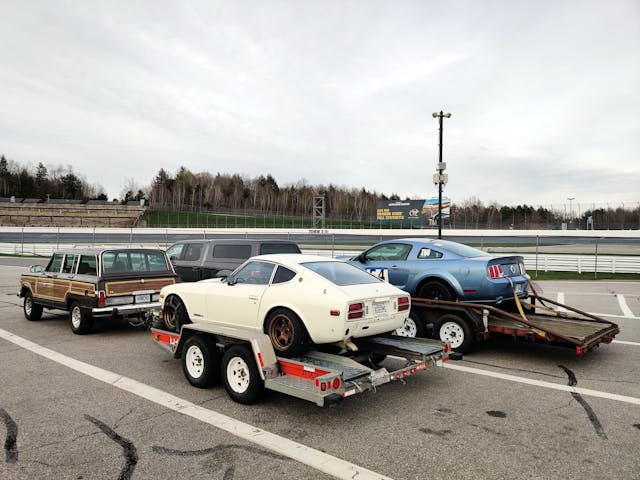
After some thought, I realized I’d crossed a line not just in terms of practicality and utility, but also safety and reason. I had built a square peg and tried to fit it into a round hole, only to then insist on rounding off the edges until I could push it through half-assed and sideways, taking my family with me for the ride.
Despite all of my preparations, tasking my Grand Wagoneer to pinch hit as an occasional tow rig is simply outside the scope of what its platform can comfortably handle. Yes, with the proper trailer and a more appropriate hitch, I’d likely have a better overall experience hauling my race car. But at the same time, I’m still asking a short-wheelbase SUV with a fairly low towing capacity to negotiate significant elevation changes and highway speeds that an a full-size truck wouldn’t sweat.
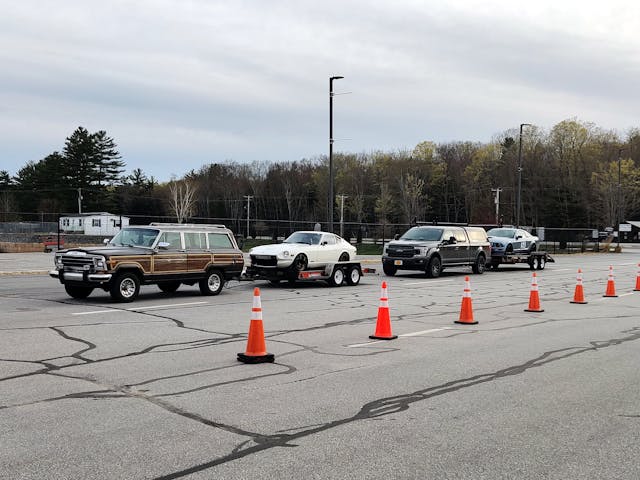
In nearly every other circumstance, I really enjoy the Jeep that I’ve built. It’s a fantastic long-range mile-eater, it brings smiles to the faces of everyone I meet driving it through Montreal’s city streets, it’s quite comfortable, and its generous cargo area makes it remarkably practical. By every non-towing measure, the Grand Wagoneer project has been a rousing success. After all, it looks great and it always starts.
I’m letting go of the tow-rig dream as a yardstick for this project’s success. The true failure here would be for me to ignore this lesson and double-down on trying, squeaking through another towing adventure with little to no margin for error. I didn’t expect a 40-year-old truck to teach me how to be at peace with my personal character flaws, but I’m grateful to have made it out of the experience with a better understanding of myself.
What else do I now understand? That a lightly-used, 21st-century pickup would find in my stable a welcome new home. Stay tuned!
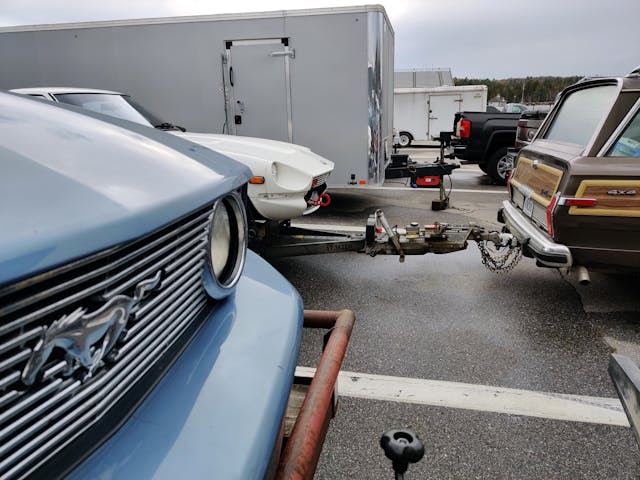
***
Check out the Hagerty Media homepage so you don’t miss a single story, or better yet, bookmark it. To get our best stories delivered right to your inbox, subscribe to our newsletters.

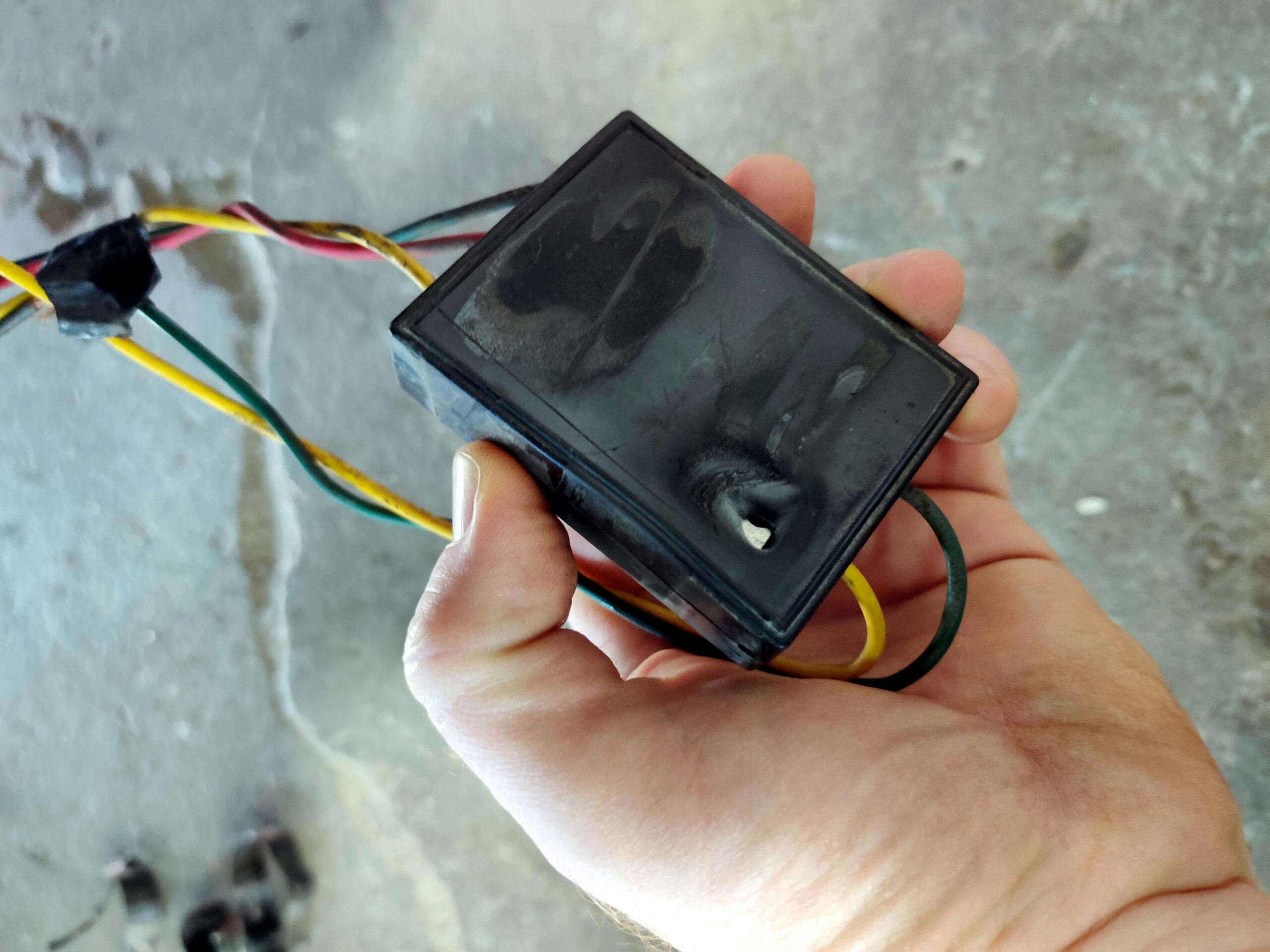

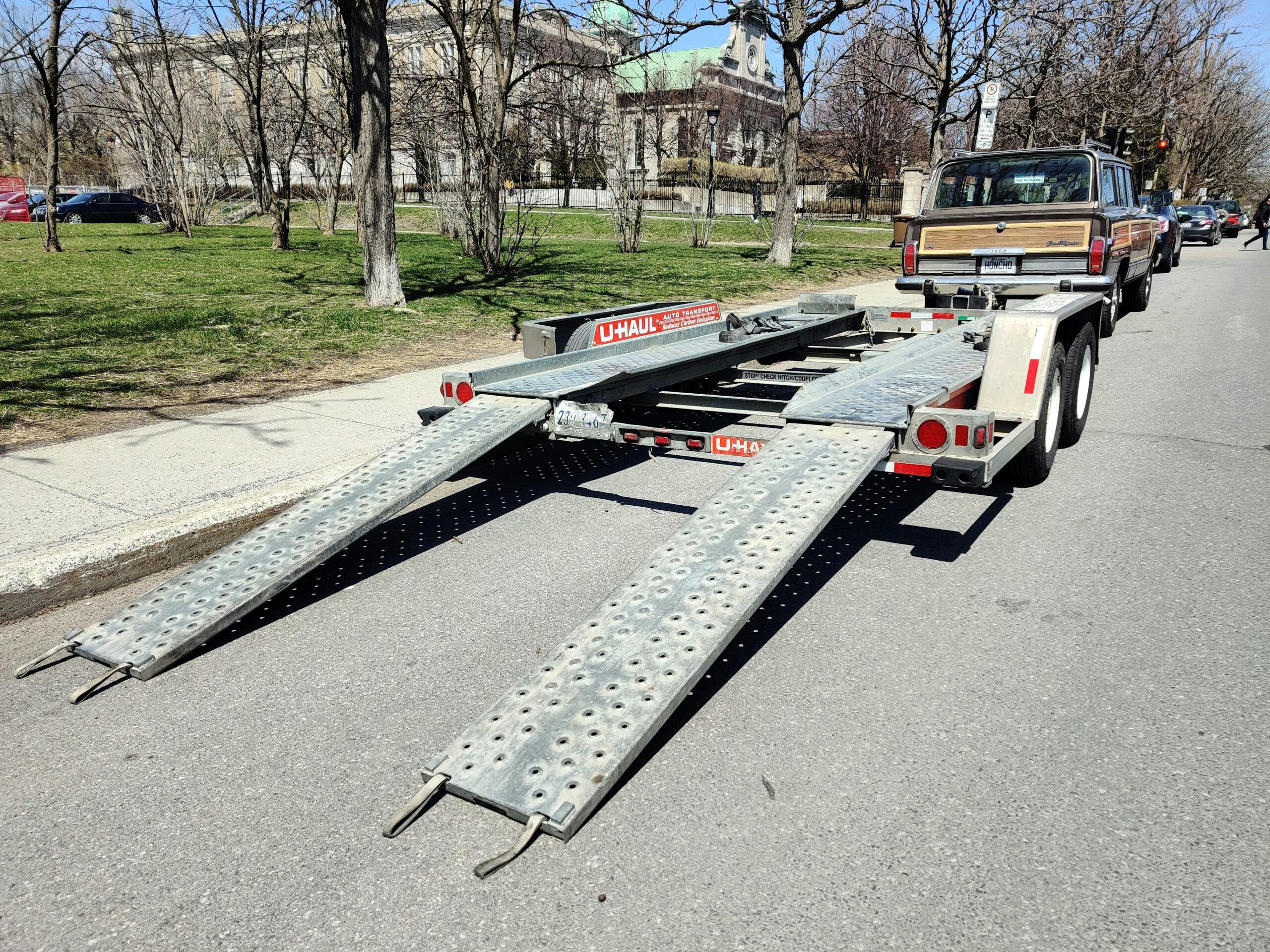
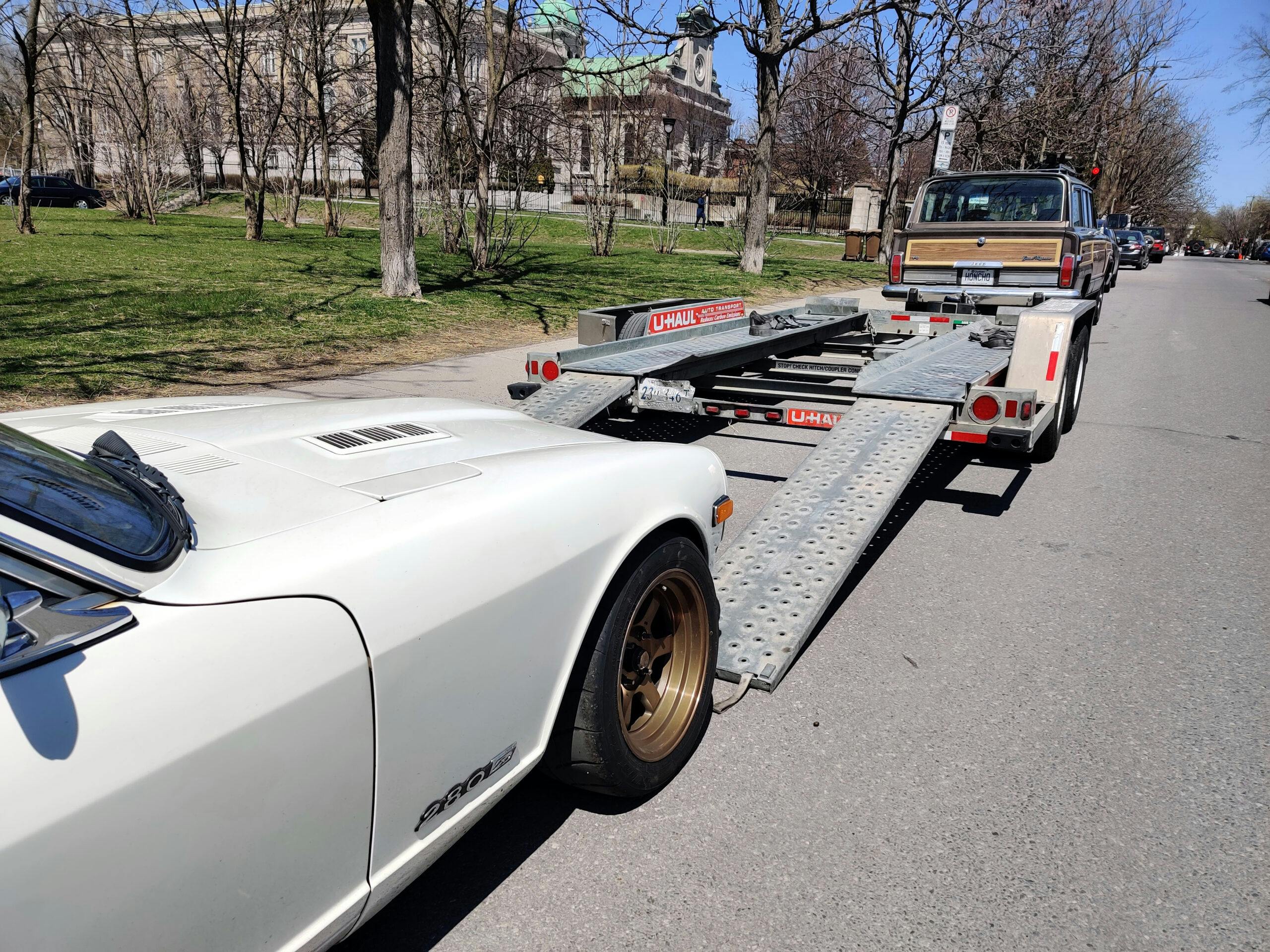


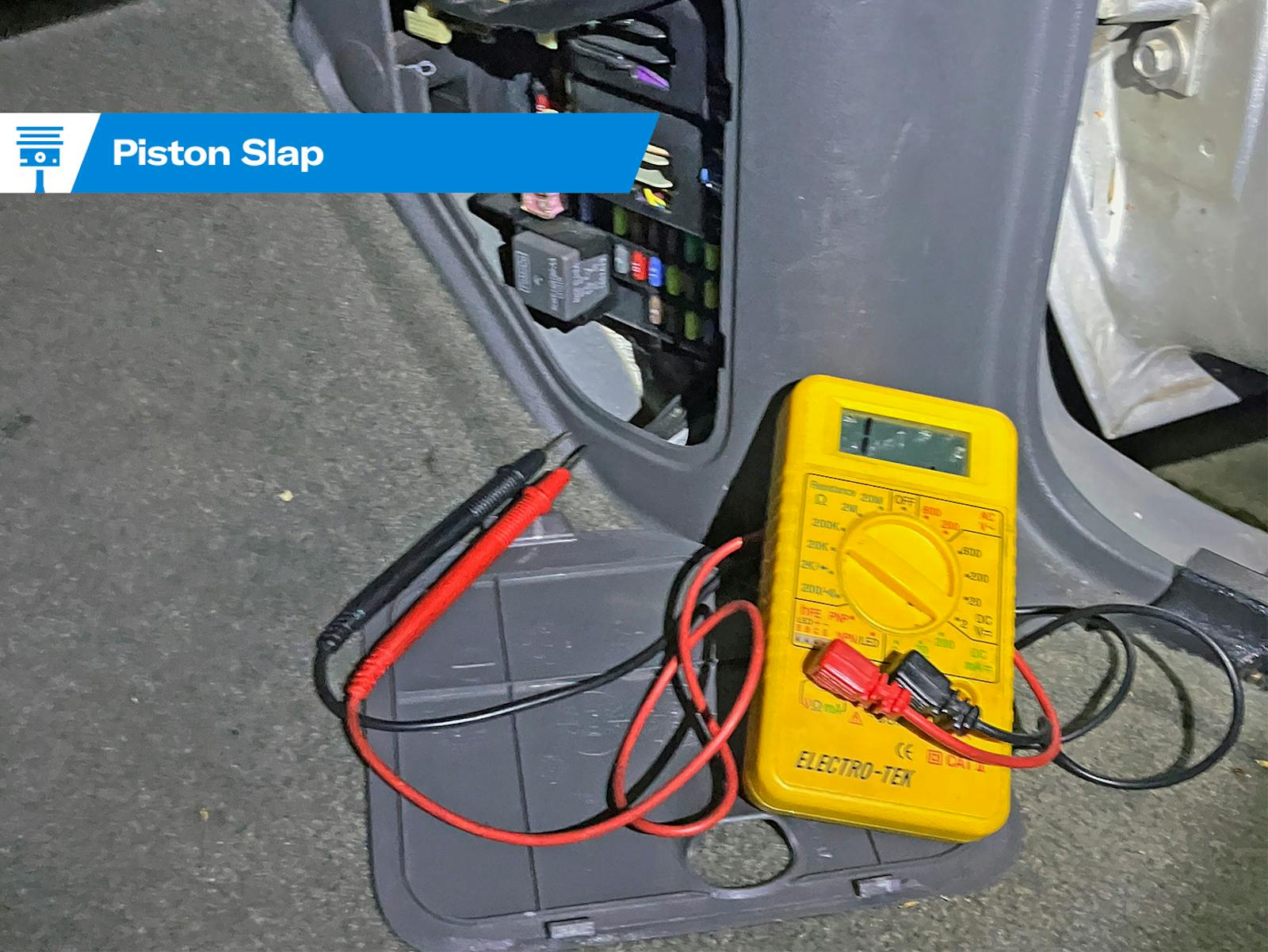
If I told my Dad that story he would ask “Did you learn something?” The answer was almost always “Yes.” Then he would tell me it was worth it then. Maybe buy a good used trailer, set up to tow that Datsun behind that GW. With U-Haul, you never know what you’re going to get. As you suggested, sway bars will go a long way. Electric brakes will also add some comfort.
A better trailer is a WORLD of difference. Being able to adjust the fore-aft position of the load, and electric brakes may very well tame the SWB tow rig.
I’m in the middle of a move to a location that is more friendly to storing a trailer, so this might be the route I end up taking, should I decide to further self-flagellate.
The trailer tire size makes a big difference also. I went from dual axle 225 15’s to 235 16’s and it was nite and day. I had a Ford E350 with a Cummins and manual transmission and could tow the new trailer empty without sway bars.
Get a used Touareg. It pulls that u-haul trailer and a car like a champ. It’s max is 7,700 lbs and it’s very comfortable in the 6k range.
1953 F100 had a 110 inch wheelbase and were surely used for towing.
I think you have too many variables in your science experiment to draw firm conclusions from.
To my limited understanding, the trailer in the photos isn’t even legal to haul a car without electric brakes where I live.
I’ve read some of the past build articles on the Jeep (headliner install I recall) but not sure you have done a “full trailer package” retrofit? Example: cooling upgrades, tow/haul mode (that’s in era for LS engines…). Maybe you have?
I do think the trailer let you down and a different trailer could give better results.
But if getting a longer truck is a viable option (vs. owning a trailer) I get that you would make that choice and spare the Jeep the wear of pushing at it’s towing max.
The Jeep does have a trans cooler, hydroboost brakes, which I specifcally added for towing purposes. There’s no tow-haul mode for the transmission I’m using, but power isn’t the problem with the FSJ platform.
A different trailer would likely go a long way towards improving the situation, as you and others in the comments have suggested. But your point about wear and tear at the limit is a good one, and it’s part of what’s pushing me to look for a more appropriate rig.
Well it is a really cool Jeep. Kind of thing you want to keep around for a long time.
Don’t tell him that! Tell he should just make a deal with DUB6 and dump it while the dumping is good! 😏
As someone who towed a jeep with a wagoneer, dump the airbags and install hellwig overload springs instead.
The thing about overload springs is, they only come into play once the suspension has already started to sag, to my understanding.
I know you said you have no place to store a trailer of your own. But if you found a place to store one, I think you’d see a lot better results with a properly set up trailer. For a car that small and light, you can get a light 16′ car hauler with 3500 lb axles, trailer brakes, and be able to position the car for better weight distribution. I agree with another poster, you’ll like heavier leaf springs in the back, but the trade off is a rougher ride when empty. A brake controller would be necessary too for the trailer brakes, which is an easy install. That Jeep is a cool ride.
I’m fortunately on the verge of acquiring trailer storage space, so I’m going to spend the winter months seeking out a better, lighter trailer – which will be a bonus even if I decide to go in another direction in terms of my tow rig. I appreciate the advice and the encouragement from everyone here.
Bought a brand-new Wagoneer in 1982 with the intention to use it as a tow vehicle for the two-horse trailer we had recently purchased. Very disappointing, even with a factory-new suspension. The Wag even sagged in the rear with nothing more than two adult rear seat passengers. Overall, one of the biggest let-downs in a new vehicle I’ve ever experienced. In addition to the poor towing performance, it had marginal handling capabilities and horrible fuel mileage. I still don’t understand the fascination folks have with them now!
We too bought a new Jeep Grand Wagoneer to tow our 5000 lb boat back in 1987. Total POS. At $35,000 cost more than a new Caddy (the Cadillac dealer also sold Jeeps). Wouldn’t maintain 55 mph towing up even a slight grade and got 6 mpg; 10 when not towing. We had the piss poor AMC 360 hyped up (towing cam, dual plane intake, Holley 600, headers) and installed an extra large gas tank. It still wouldn’t tow and the gas mileage got worse. The brakes sucked and the suspension needed beefed up so there went another $3000. And people want them now more than ever. Go figure.
Mike Deason is, I believe, correct – airbags aren’t the right answer here. And I get that any advice is probably too late for you as 1) it might only correct one of your several issues, and 2) you’ve apparently made up your might to move on from the concept – but, this piece of advice might apply to other instances as well: you mention that the car had to be pulled clear forward to harness it correctly, and that put an inordinate amount of weight onto the tongue. In looking at the pics, it looks to me like you might’ve backed it on instead, thus putting the weight of the engine (and possibly trans) at least over, if not slightly behind, the trailer axles. This takes some weight off the tongue and counterbalances the weight distribution. Now, one must be careful to not take TOO MUCH off the tongue and put it out rearward – that gives you tongue lift and creates a who different issue. But – and it’s only guessing from picture angles – I think your Z is short enough that that wouldn’t be a problem.
At-any-rate, I’ll renew my (multiple-times-made) offer to take that Jeep off your hands when you’re ready to look at a more suitable tow rig 😁
Yeah, too little tongue weight is disastrous. I sold a 1971 P30 (with a 292 4 speed) to a guy from FL. He was headed to MS with a U-haul trailer, even though I had posted the dimensions in the ad. It wouldn’t fit, and I thankfully caught his error before he was too far out of his hometown. When he showed up with a different trailer from another company, it was tilt deck! I told him he was going to have too much weight behind the axle once it was loaded, and it was going to be wagging his truck over 35 mph. It was a chore to even get the thing loaded since the deck wanted to tilt back down before the rear wheels were even on. Anyway, he called me a few miles down the road, sure enough, he could only get just above 30 before the tail started wagging the dog. He said he drove from central MS to FL at 30 mph the whole way.
Yeah, my Hemi pick up tows great, but I have a number of Waggy’s and I use them for tow duty as well. Yeah they react different than a long wheel base pick up but I guess I got used to it? I use lighter trailers for sure and tow dollies but tow my 944’s, 924’s, 968’s, 928s, E24 BMW’s, W126 Mercedes’ and Corvettes with my G.W.’s all the time without stress. I’ve even towed them through storms and snow, towing with 4 Wheel Drive Engaged. A task I would probably choose the G.W. over my Hemi RAM for.
I have towed using my ML350 diesel with a uHaul trailer and had absolutely no issues, even though its wheelbase is only 114 inches, so you don’t need a pickup to haul your Z. My Benz has Airmatic, which might have helped. I am guessing the tongue weight of your load may have been near or beyond your GW’s capacity.
I feel your pain. I bought a 94 Roadmaster wagon (LT1) with the tow package. I towed my 04 Z06 on a 17 aluminum trailer. It did the job but didn’t like it. Sold it and got an 06 K2500 Suburban with an 8.1 and 4.10 gears. Stress level way down. Both vehicles used my distributing hitch but really don’t need it with the Sub.
May I suggest your issue was not so much with the wheelbase, but with the trailer. Those trailers are s . . t, find a good used longer wheelbase trailer with electric brakes and get a few pounds more weigh forward and move the ramps up forward, and get some load levelers at a swap meet if necessary; it’s only 6″ shorter than a std. cab, short bed pickup which I have and it tows my RR Silver Cloud II just fine on an 18 ft std. car trailer.
Having towed my 1957 Corvette to the vintage races all over the west coast with my 1964 El Camino. My comment is the pictures look like way to much tongue weight. Too much tongue weight will drastically affect steering. uHaul trailers are for emergency use only.
My orange ’72 Wagoner was a towing champ with stock everything (360, 2bbl, at, drum brakes). We called it the Great Pumpkin.
It’s a Jeep thing. Now you understand.
Glad everyone made it back/forth safely. Yeah it is disappointing it did not work as configured now but it sounds like you are on your way to a reliable tow rig.
100# of tongue is a good starting point. And test “tow” your setup before a big journey, that way you can tune the tongue weight for a comfortable feel. This advice from a guy who once had to follow a borrowed trailer off road as it proceeded to take complete control of the tow rig.